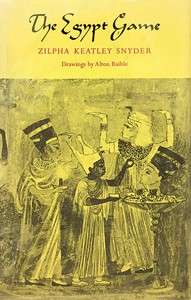The Egypt Game
The Egypt Game (1967) is a Newbery Honor-winning novel by Zilpha Keatley Snyder. Set in a small college town in California, the novel follows the creation of a sustained imaginative game by a group of six children.
 First edition | |
| Author | Zilpha Keatley Snyder |
|---|---|
| Publisher | Atheneum |
Plot summary
April Hall, the daughter of an up-and-coming film actress, is sent to live with her grandmother in an old apartment house in Berkeley, California. She feels abandoned and masks her grief with truculent sarcasm and Hollywood mannerisms. Her grandmother arranges for her to meet neighbor children Melanie and Marshall Ross, and they bond over "imagining games" and a shared interest in archaeology. April also investigates a nearby antique shop run by a mysterious and somewhat spooky old man known as The Professor. In the shop's storage yard, the girls discover a replica of the famous bust of Nefertiti, leading them to create a sustained imaginary game about Ancient Egypt.
They research actual Ancient Egyptian belief systems and practices, and create their own rituals intended to reproduce them more or less authentically. They are joined by Elizabeth Chung, a nine-year-old Chinese American girl whom they see as resembling a young Nefertiti.
At Halloween the children desert their trick or treat group to return to Egypt surreptitiously and are discovered by their aggressive, outgoing classmates Toby Alvillar and Ken Kamata. Melanie and April fear they will ruin everything, but Elizabeth invites them into the game if they will keep it secret. Ken is unenthusiastic and nonchalant initially, but Toby is fascinated, and quickly brings in useful material and ideas.
A little girl from the neighborhood disappears and is found murdered, the second such crime in a year. All the children from the area are kept indoors for several weeks. When allowed to play outdoors again, the "Egyptians" devise an oracle connected to Thoth, and are unnerved by some of its answers. A series of unexplained events lead them to wonder if they should stop playing completely.
April returns to Egypt at night to retrieve a lost schoolbook, and is attacked by the murderer. The Professor witnesses the attack, breaks the back window of his store and shouts for help. Professor tells the children that he has been watching the game the whole time, intrigued by how they interpreted and recreated Egyptian myths and history. A widower, he became reclusive after his wife's death.
The children feel that the game cannot continue because its essential secrecy has been destroyed. The book ends with April raising the possibility of a new game involving Gypsies.
Legacies
Snyder followed up on the possibility open at the end of the book by writing The Gypsy Game (1997).
The gaming scholar Cathlena Martin demonstrated how the book preceded (and maybe influenced) the role-playing gameplay designs of Dungeons & Dragons (1974).[1]
References
- Martin, Cathlena. 2018. “Role Playing in Children’s Literature. Zilpha Keatley Snyder and The Egypt Game.” American Journal of Play 10 (2): 208–28.